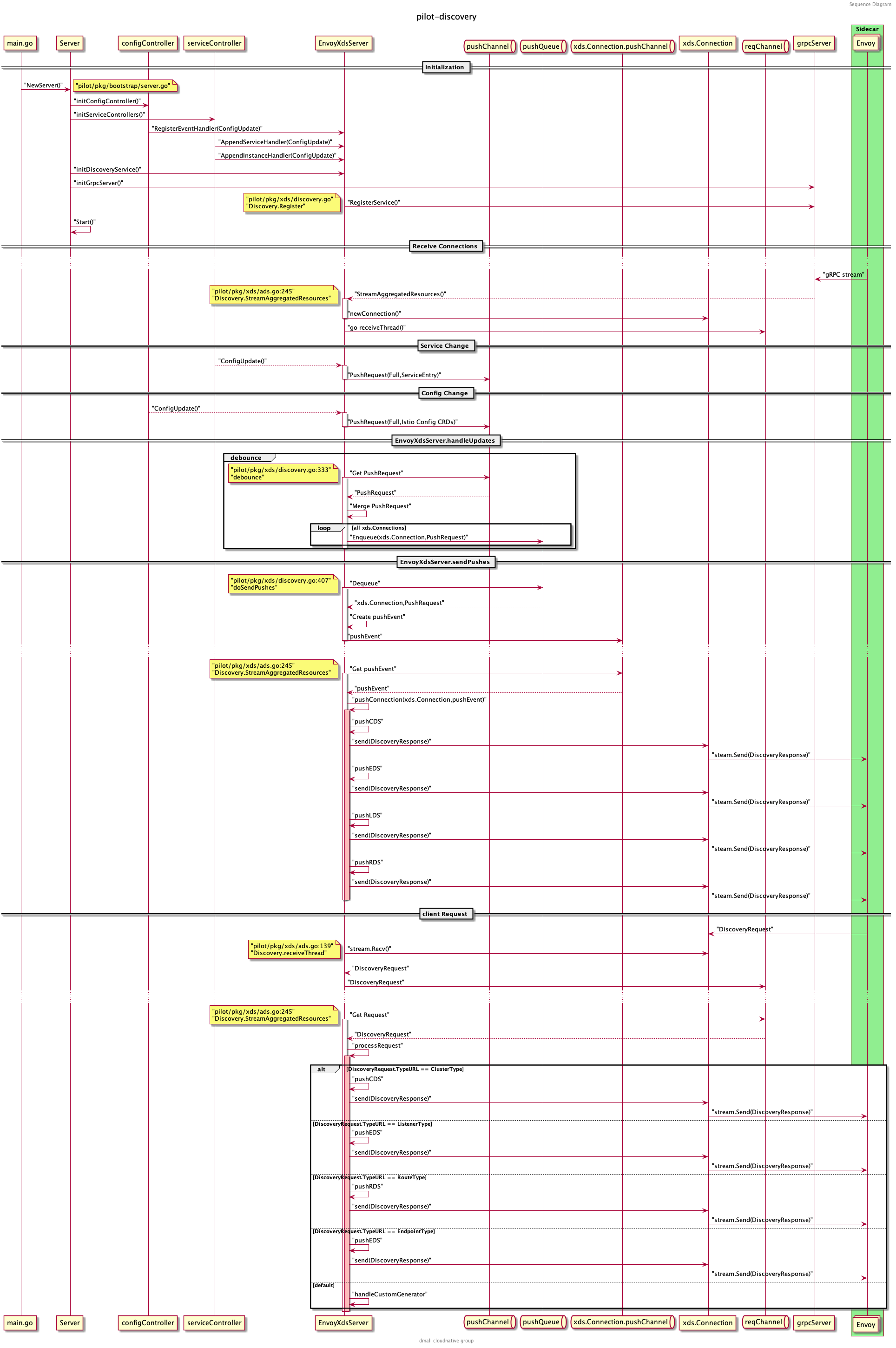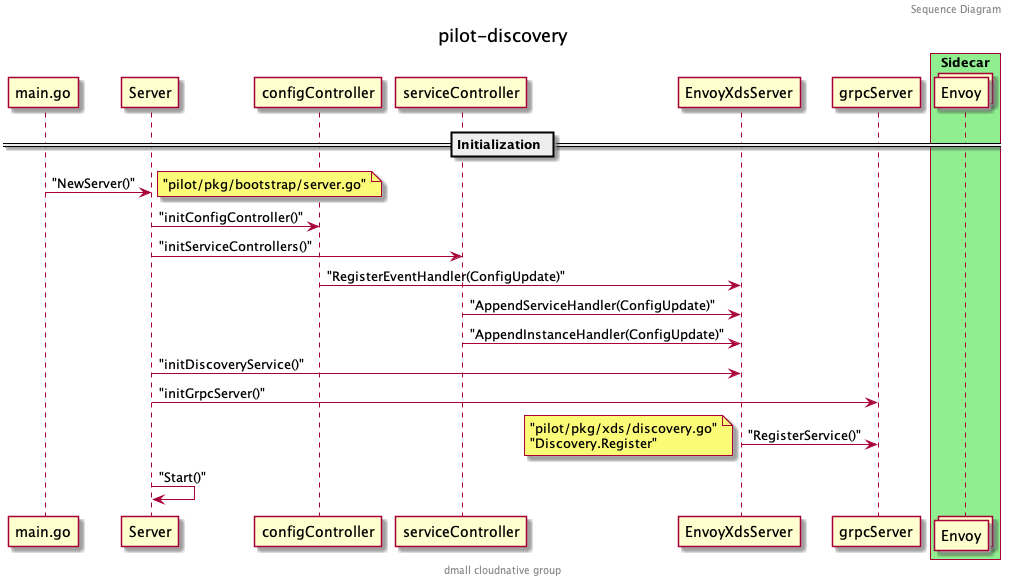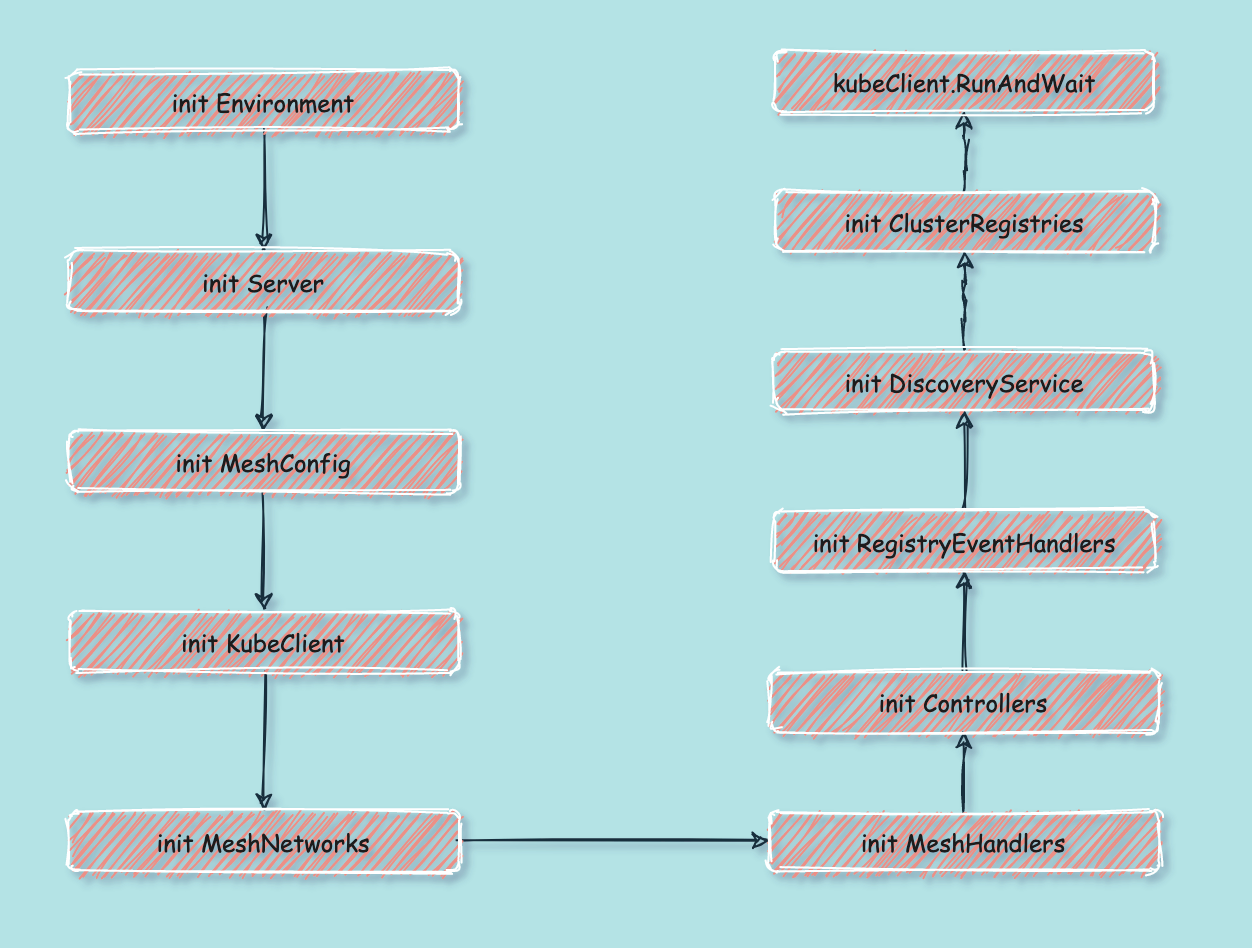Istio Pilot 源码分析(一)
Istio 作为目前 ServiceMesh 方案中的翘楚,吸引着越来越多的企业及开发者。越来越多的团队想将其应用于微服务的治理,但在实际落地时却因为不了解 Istio 黑盒中的运行机制而左右为难,本文将基于 1.7 的源码讲解 Istio 的核心组件 Pilot 的结构及运行流程,希望对读者应用 Istio 有所助益。
注:本文基于 istio release-1.7 分支分析,其他版本的代码结构会有所不同。
背景
随着 Istio 1.7 的发布,内部组件精简后的 istiod 日趋稳定,越来越多的公司将其应用到自身微服务的流量治理、安全通信及监测中。多点也不例外,应用 Istio 来落地业务系统所有 Dubbo 服务的网格化,下沉 SDK 逻辑,解决基础中间件与业务系统过于耦合等痛点。 目前,我们是通过自己开发的 Controller 组件对接 Zookeeper 等注册中心,将注册到 Zookeeper 的节点实时转化为 ServiceEntry 及 WorkloadEntry 等 Istio 配置类型写入 kube-apiserver,再由 Pilot 转化为 xDS 协议下发至数据面,同时对集群、虚拟机中的服务进行治理。随着公司服务网格化的逐步落地,对 Istio 及数据面组件源码级掌握的诉求越来越高,没有足够的深度及广度很难解决开发过程中遇到的难题,让我们一起揭开 Istio 神秘的面纱,看看黑箱内部是如何运作的。
本文作为 Istio 控制面组件 Pilot 的源码分析系列,主要面向刚接触 Istio 或仅停留在使用 Istio 基本配置类型(如 VirtualService、DestinationRule 等)的同学,需要熟悉 Istio 的一些 基础概念及名词 。文章会涉及较多的代码细节,我们会以不同的篇幅分别介绍以下内容:
pilot-discovery宏观架构及启动流程梳理pilot-discovery接口设计及关键接口分析pilot-discovery xDS生成及下发流程梳理pilot-agent流程梳理pilot中的身份认证及安全通信解析
相信通过源码一步一步分析,能消除读者对 Pilot 的陌生感,在基于 Pilot 做适配开发时会更加清楚的了解其底层运行逻辑,碰到问题时也能更好的定位。
Pilot 的代码主要分为两部分:
pilot-discoverypilot-agent
其中 pilot-agent 负责数据面 Sidecar 实例的生命周期管理,而 pilot-discovery 负责控制面流量管理配置及路由规则的生成和下发。
宏观架构
pilot-discovery 的核心组件如图:
其中 Server 为 pilot-discovery 的主服务,包含了三个比较重要的组件:
Config Controller:从不同来源接收流量控制和路由规则等Istio的配置,并响应各类事件。Service Controller:从不同注册中心同步服务及实例,并响应各类事件。EnvoyXdsServer:核心的xDS协议推送服务,根据上面组件的数据生成xDS协议并下发。
Config Controller 比较核心的就是对接 Kubernetes,从 kube-apiserver 中 Watch 集群中的 VirtualService、ServiceEntry、DestinationRules 等配置信息,有变化则生成 PushRequest 推送至 EnvoyXdsServer 中的推送队列。除此之外,还支持对接 MCP(Mesh Configuration Protocol) 协议的 gRPC Server,如 Nacos 的 MCP 服务等,只需要在 meshconfig 中配置 configSources 即可。最后一种是基于内存的 Config Controller 实现,通过 Watch 一个文件目录,加载目录中的 yaml 文件生成配置数据,主要用来测试。
Service Controller 目前原生支持 Kubernetes 和 Consul,注册在这些注册中心中的服务可以无痛接入 Mesh,另外一种比较特殊,就是 ServiceEntryStore,它本质是储存在 Config Controller 中的 Istio 配置数据,但它描述的却是集群外部的服务信息,详情可阅读文档 ServiceEntry,Istio 通过它将集群外部,如部署在虚拟机中的服务、非 Kubernetes 的原生服务同步到 Istio 中,纳入网格统一进行流量控制和路由,所以 ServiceEntryStore 也可以视为一种注册中心。还有一种就是 Mock Service Registry,主要用来测试。
ServiceEntryStore 从 Config Controller 到 Service Controller 的转化流程大致如图(后续会做详细的代码分析,这里简单了解一下即可):

ConfigStores 是一个列表,里面存储了各类 Istio 配置文件,包括 ServiceEntry 、WorkloadEntry 等服务数据,也包括 VirtualService、DestinationRules、Sidecar 等流量控制、路由规则的配置数据,pilot-discovery 将这些 ConfigStores 聚合成一个 configController 统一进行管理,之后再从其中衍生出 IstioConfigStore,将其作为 serviceEntryStore 的配置源。serviceEntryStore 其实就是 ServiceEntry Controller,响应 ServiceEntry 和 WorkloadEntry 这类服务信息的变化。
EnvoyXdsServer 比较核心,一切与 xDS 协议相关的接收、转换、下发操作都由它完成。EnvoyXdsServer 对接所有集群中的边车代理,如 Envoy、MOSN 等,当配置或服务发生变化时主动推送,也会响应代理发送的请求,依据请求的信息下发相应的 xDS 配置。
理解了这三个核心组件的定义,就能比较好的理解下面分析的各类流程了。
pilot-discovery 的整个业务流程梳理如下,可以先大概浏览一遍,之后我们逐一进行分析:
启动流程梳理
首先详细看一下 pilot-discovery 的启动流程。pilot-discovery 组件的入口代码在 istio/pilot/cmd/pilot-discovery 中。该目录中包含两个文件: main.go 和 request.go。main.go 中定义了 pilot-discovery 根命令及 discovery 命令,是启动服务发现及配置下发的主流程; 另一个文件 request.go 中定义了 request 命令,用来请求 Pilot 中的 metrics/debug 接口,多用来调试。
main.go 中 discoveryCmd的 RunE 函数定义了启动过程,代码如下:
// 创建一个接收空结构的 stop channel 用来停止所有 servers |
启动流程如图所示:
初始化流程
接下来介绍 discoveryServer ,即 pilot-discovery 组件的核心。在这之前先看下 Server 的结构,代码位于 istio/pilot/pkg/bootstrap/server.go 文件中。
Server 的关键字段如下:
type Server struct { |
再看 NewServer() 方法中的内容,有以下几个关键步骤:

我们对每个步骤逐一进行分析:
初始化
Environment什么是
Environment呢?根据定义Environment为Pilot提供了一个汇总的、运行中所需的 API 集合。Environment中字段(接口)如下:type Environment struct {
ServiceDiscovery // 服务发现的接口模型,主要列出 services 和 instances
IstioConfigStore // Istio 配置文件的存储器,主要列出 ServiceEntry 等配置
mesh.Watcher // mesh config 文件的监听器
mesh.NetworksWatcher // mesh network config 文件的监听器
PushContext *PushContext // 在推送(下发 xDS)生成期间保存信息的上下文
DomainSuffix string // istio server 默认的后缀域名
}其中
PushContext是Pilot在推送xDS前,生成配置期间保存相关信息的上下文的地方,在全量推送配置和配置发生改变时重置。它会保存所有的错误和统计信息,并缓存一些配置的计算信息。ServiceDiscovery提供了枚举Istio中服务和实例的方法。mesh.Watcher和mesh.NetworksWatcher负责监听istiod启动时挂载的两个配置文件,这两个配置文件是通过configmap映射到Pod的文件系统中的,监听器将在监听到配置文件变化时运行预先注册的Handler。文件挂载参考istiod的配置文件:apiVersion: v1
kind: Pod
metadata:
name: istiod-56c488887d-z9k5c
namespace: istio-system
spec:
containers:
volumeMounts:
- mountPath: /etc/istio/config
name: config-volume
volumes:
- configMap:
defaultMode: 420
name: istio
name: config-volume相应的配置存储在
istio-system/istio这个configmap中,里面保存了mesh和meshNetworks两种配置,样例如下:apiVersion: v1
kind: ConfigMap
metadata:
name: istio
namespace: istio-system
data:
mesh: |-
accessLogEncoding: TEXT
accessLogFile: ""
accessLogFormat: ""
defaultConfig:
binaryPath: /usr/local/bin/mosn
concurrency: 2
configPath: ./etc/istio/proxy
...
meshNetworks: 'networks: {}'再回头看
Environment的初始化:e := &model.Environment{
PushContext: model.NewPushContext(),
DomainSuffix: args.RegistryOptions.KubeOptions.DomainSuffix,
}
ac := aggregate.NewController(aggregate.Options{
MeshHolder: e,
})
e.ServiceDiscovery = ac首先是初始化了一份
PushContext,创建PushContext所需的各种列表和Map。 其次是初始化了一个聚合所有注册中心的Controller作为Environment中的ServiceDiscovery。 该Controller提供从所有注册中心(如Kubernetes, Consul, MCP等)获取服务和实例列表的方法。 这里传入了一个参数MeshHolder是想利用Environment中的mesh.Watcher将mesh这个配置同步过去。初始化
ServerServer的结构之前分析过,这里将之前初始化的Environment传入后,开始初始化XDSServer。s := &Server{
clusterID: getClusterID(args),
environment: e,
XDSServer: xds.NewDiscoveryServer(e, args.Plugins), // 初始化 XDSServer
fileWatcher: filewatcher.NewWatcher(),
httpMux: http.NewServeMux(),
monitoringMux: http.NewServeMux(),
readinessProbes: make(map[string]readinessProbe),
}XDSServer相关的代码在istio/pilot/pkg/xds/discovery.go中,对应为DiscoveryServer,该服务为Envoy xDS APIs的gRPC实现。DiscoveryServer关键定义如下:type DiscoveryServer struct {
Env *model.Environment // 即上述 pilot server 中的 Environment
ConfigGenerator core.ConfigGenerator // 控制面 Istio 配置的生成器,如 VirtualService 等
Generators map[string]model.XdsResourceGenerator // 针对不同配置类型的定制化生成器
concurrentPushLimit chan struct{}
// 不同服务所有实例的集合,增量更新,key 为 service 和 namespace
// EndpointShards 中是以不同的注册中心名为 key 分组保存实例
EndpointShardsByService map[string]map[string]*EndpointShards
pushChannel chan *model.PushRequest // 接收 push 请求的 channel
pushQueue *PushQueue // 防抖之后,真正 Push xDS 之前所用的缓冲队列
adsClients map[string]*Connection // ADS 和 EDS 的 gRPC 连接
StatusReporter DistributionStatusCache // 监听 xDS ACK 和连接断开
// xDS 状态更新的生成器(更新 connect, disconnect, nacks, acks)
// 状态更新后向所有 connection 推送 DiscoveryResponse
InternalGen *InternalGen
serverReady bool // 表示缓存已同步,server 可以接受请求
debounceOptions debounceOptions // 防抖设置
cache Cache // xDS 资源的缓存,目前仅适用于 EDS,线程安全
}初始化
MeshConfig、KubeClient、MeshNetworks和MeshHandlerss.initMeshConfiguration(args, s.fileWatcher)
if err := s.initKubeClient(args); err != nil {
return nil, fmt.Errorf("error initializing kube client: %v", err)
}
s.initMeshNetworks(args, s.fileWatcher)
s.initMeshHandlers()这几个初始化函数比较好理解,
initMeshConfiguration和initMeshNetworks都是通过fileWatcher对istiod从configmap中挂载的两个配置文件mesh和meshNetworks进行监听。当配置文件发生变化时重载配置并触发相应的Handlers。filewatcher的代码在另一个管理通用工具包的项目里:github.com/istio/pkg/filewatcher,感兴趣的同学可以再详细研究下,底层使用到了 fsnotify 这个库来推送文件变化事件。initMeshHandlers为上述两个配置文件注册了两个Handler,当配置文件发生变化时触发全量xDS下发。初始化
Controllers这部分比较核心,初始化了三种控制器分别处理证书、配置信息和注册信息,证书及安全相关的内容本篇先暂不讨论。主要来看
initConfigController和initServiceControllers。func (s *Server) initControllers(args *PilotArgs) error {
log.Info("initializing controllers")
if err := s.initCertController(args); err != nil {
return fmt.Errorf("error initializing certificate controller: %v", err)
}
if err := s.initConfigController(args); err != nil {
return fmt.Errorf("error initializing config controller: %v", err)
}
if err := s.initServiceControllers(args); err != nil {
return fmt.Errorf("error initializing service controllers: %v", err)
}
return nil
}配置信息大都是
Istio定义的一系列CRD(如VirtualService、DestinationRules等),一个控制面可以通过MCP同时接入多个Kubernetes之外的配置数据源,也可通过文件目录(主要用来调试)挂载,默认是读取 Kubernetes 中的配置数据:func (s *Server) initK8SConfigStore(args *PilotArgs) error {
configController, err := s.makeKubeConfigController(args)
...
s.initStatusController(args, features.EnableStatus) // 初始化上面提到的 StatusReporter
return nil
}配置数据包括以下类型,具体每个类型的含义
Istio官网都有介绍及用例,这里不再赘述:// PilotServiceApi contains only collections used by Pilot, including experimental Service Api.
PilotServiceApi = collection.NewSchemasBuilder().
MustAdd(IstioNetworkingV1Alpha3Destinationrules).
MustAdd(IstioNetworkingV1Alpha3Envoyfilters).
MustAdd(IstioNetworkingV1Alpha3Gateways).
MustAdd(IstioNetworkingV1Alpha3Serviceentries).
MustAdd(IstioNetworkingV1Alpha3Sidecars).
MustAdd(IstioNetworkingV1Alpha3Virtualservices).
MustAdd(IstioNetworkingV1Alpha3Workloadentries).
MustAdd(IstioNetworkingV1Alpha3Workloadgroups).
MustAdd(IstioSecurityV1Beta1Authorizationpolicies).
MustAdd(IstioSecurityV1Beta1Peerauthentications).
MustAdd(IstioSecurityV1Beta1Requestauthentications).
MustAdd(K8SServiceApisV1Alpha1Gatewayclasses).
MustAdd(K8SServiceApisV1Alpha1Gateways).
MustAdd(K8SServiceApisV1Alpha1Httproutes).
MustAdd(K8SServiceApisV1Alpha1Tcproutes).
Build()详细看下
initK8SConfigStore中的makeKubeConfigController方法,这里初始化了一个处理Istio CRDs的Client,实现ConfigStoreCache这个接口中增删改查等方法。func (s *Server) makeKubeConfigController(args *PilotArgs) (model.ConfigStoreCache, error) {
c, err := crdclient.New(s.kubeClient, buildLedger(args.RegistryOptions), args.Revision, args.RegistryOptions.KubeOptions)
if err != nil {
return nil, err
}
return c, nil
}Client定义如下:type Client struct {
schemas collection.Schemas // Istio CRDs shemas
domainSuffix string
configLedger ledger.Ledger
revision string
kinds map[resource.GroupVersionKind]*cacheHandler // 跟踪已知类型的所有缓存 handler
queue queue.Instance
istioClient istioclient.Interface
serviceApisClient serviceapisclient.Interface
}再依次对这些类型创建
Informer开启监听。回到initConfigController,创建好ConfigStore之后,再对其进一步包装:// 将所有 ConfigStore 聚合并缓存
aggregateConfigController, err := configaggregate.MakeCache(s.ConfigStores)
// 通过 s.configController 统一操作上面聚合的 ConfigStores
s.configController = aggregateConfigController
// 将其包装为 IstioConfigStore 传入 environment,便于操作 ServiceEntry/Gateway 等资源
// IstioConfigStore 会在之后的 ServiceEntryStore 中用到
s.environment.IstioConfigStore = model.MakeIstioStore(s.configController)最后将该
Controller的启动函数注册到startFuncs中:s.addStartFunc(func(stop <-chan struct{}) error {
go s.configController.Run(stop)
return nil
})再来看
initServiceControllers处理服务发现的Controller初始化:func (s *Server) initServiceControllers(args *PilotArgs) error {
serviceControllers := s.ServiceController()
for _, r := range args.RegistryOptions.Registries {
// ...
switch serviceRegistry {
case serviceregistry.Kubernetes:
if err := s.initKubeRegistry(serviceControllers, args); err != nil {
return err
}
// ...
}
// ...
}从之前初始化的
environment.ServiceDiscovery中获取已注册的服务中心,如果是Kubernetes则执行initKubeRegistry:// initKubeRegistry creates all the k8s service controllers under this pilot
func (s *Server) initKubeRegistry(serviceControllers *aggregate.Controller, args *PilotArgs) (err error) {
// ...
log.Infof("Initializing Kubernetes service registry %q", args.RegistryOptions.KubeOptions.ClusterID)
kubeRegistry := kubecontroller.NewController(s.kubeClient, args.RegistryOptions.KubeOptions)
s.kubeRegistry = kubeRegistry
serviceControllers.AddRegistry(kubeRegistry)
return
}进一步初始化
Kubernetes注册中心,方法为NewController,先看一下这个Controller的结构:type Controller struct {
client kubernetes.Interface
queue queue.Instance
serviceInformer cache.SharedIndexInformer
serviceLister listerv1.ServiceLister
endpoints kubeEndpointsController
nodeInformer cache.SharedIndexInformer
nodeLister listerv1.NodeLister
pods *PodCache
metrics model.Metrics
networksWatcher mesh.NetworksWatcher
xdsUpdater model.XDSUpdater
domainSuffix string
clusterID string
serviceHandlers []func(*model.Service, model.Event)
instanceHandlers []func(*model.ServiceInstance, model.Event)
workloadHandlers []func(*model.WorkloadInstance, model.Event)
sync.RWMutex
servicesMap map[host.Name]*model.Service
nodeSelectorsForServices map[host.Name]labels.Instance
nodeInfoMap map[string]kubernetesNode
externalNameSvcInstanceMap map[host.Name][]*model.ServiceInstance
workloadInstancesByIP map[string]*model.WorkloadInstance
ranger cidranger.Ranger
networkForRegistry string
once sync.Once
}可以看到
Controller对Services、Nodes、Pods等资源各自初始化了Informer、 Lister 以及对应的 Map,各类 Handlers 在 Informer 监听到增删改查时推送相应的事件到 queue ,再由onServiceEvent、onNodeEvent、c.pods.onEvent中更新对应的 Map 。回到
initServiceControllers,初始化完 Kubernetes 注册中心之后,还需要关注 Kubernetes 集群之外的服务,这些服务基本都是通过ServiceEntry注册到控制面的,所有ServiceEntry配置数据目前还都在之前初始化的configController配置中心控制器中,这里将ServiceEntry数据单独拎出来初始化一个ServicEntry注册中心,加入到serviceControllers中:s.serviceEntryStore = serviceentry.NewServiceDiscovery(
s.configController, s.environment.IstioConfigStore, s.XDSServer)
serviceControllers.AddRegistry(s.serviceEntryStore)serviceEntryStore相关的逻辑会在后续 xDS 下发流程的分析中再阐述。最后将
serviceControllers中所有的服务注册中心的Controller的启动函数都注册到startFuncs中:s.addStartFunc(func(stop <-chan struct{}) error {
go serviceControllers.Run(stop)
return nil
})// Run starts all the controllers
func (c *Controller) Run(stop <-chan struct{}) {
for _, r := range c.GetRegistries() {
go r.Run(stop)
}
<-stop
log.Info("Registry Aggregator terminated")
}初始化
RegistryEventHandlersinitRegistryEventHandlers设置了三个事件处理器serviceHandler、instanceHandler和configHandler分别响应服务、实例和配置数据的更新事件。serviceHandler如下:serviceHandler := func(svc *model.Service, _ model.Event) {
pushReq := &model.PushRequest{
Full: true,
ConfigsUpdated: map[model.ConfigKey]struct{}{{
Kind: gvk.ServiceEntry,
Name: string(svc.Hostname),
Namespace: svc.Attributes.Namespace,
}: {}},
Reason: []model.TriggerReason{model.ServiceUpdate},
}
s.XDSServer.ConfigUpdate(pushReq)
}
if err := s.ServiceController().AppendServiceHandler(serviceHandler); err != nil {
return fmt.Errorf("append service handler failed: %v", err)
}可以看到当服务本身发生变化时,会触发
xDS的全量下发,所有与该服务相关的代理都会收到推送。实例的变动也会触发
xDS的全量下发,不过仅在连接Consul时生效。Kubernetes和MCP这两种服务发现的场景下,更新事件的Handler是在别的地方注册的。instanceHandler := func(si *model.ServiceInstance, _ model.Event) {
// TODO: This is an incomplete code. This code path is called for consul, etc.
// In all cases, this is simply an instance update and not a config update. So, we need to update
// EDS in all proxies, and do a full config push for the instance that just changed (add/update only).
s.EnvoyXdsServer.ConfigUpdate(&model.PushRequest{
Full: true,
ConfigsUpdated: map[model.ConfigKey]struct{}{{
Kind: gvk.ServiceEntry,
Name: string(si.Service.Hostname),
Namespace: si.Service.Attributes.Namespace,
}: {}},
Reason: []model.TriggerReason{model.ServiceUpdate},
})
}
// 跳过 Kubernetes 和 MCP
for _, registry := range s.ServiceController().GetRegistries() {
// Skip kubernetes and external registries as they are handled separately
if registry.Provider() == serviceregistry.Kubernetes ||
registry.Provider() == serviceregistry.External {
continue
}
if err := registry.AppendInstanceHandler(instanceHandler); err != nil {
return fmt.Errorf("append instance handler to registry %s failed: %v", registry.Provider(), err)
}
}上一步初始化了
configController,它操作的对象主要是像VirtualService、DestinationRules这些Istio定义的配置,这些配置的变化也会触发xDS的全量下发,所有与该配置相关的代理都会收到推送。不过ServiceEntry和WorkloadEntry除外,这两个资源的配置下发是由ServiceEntryStore管理的,之前在初始化ServiceController时定义的s.serviceEntryStore会处理,之后的篇幅再做详细介绍。configHandler := func(_, curr model.Config, event model.Event) {
pushReq := &model.PushRequest{
Full: true,
ConfigsUpdated: map[model.ConfigKey]struct{}{{
Kind: curr.GroupVersionKind,
Name: curr.Name,
Namespace: curr.Namespace,
}: {}},
Reason: []model.TriggerReason{model.ConfigUpdate},
}
s.EnvoyXdsServer.ConfigUpdate(pushReq)
}下面是跳过
ServiceEntry和WorkloadEntry的代码:for _, schema := range schemas {
// This resource type was handled in external/servicediscovery.go, no need to rehandle here.
if schema.Resource().GroupVersionKind() == collections.IstioNetworkingV1Alpha3Serviceentries.
Resource().GroupVersionKind() {
continue
}
if schema.Resource().GroupVersionKind() == collections.IstioNetworkingV1Alpha3Workloadentries.
Resource().GroupVersionKind() {
continue
}
s.configController.RegisterEventHandler(schema.Resource().GroupVersionKind(), configHandler)
}初始化
DiscoveryServicefunc (s *Server) initDiscoveryService(args *PilotArgs) error {
log.Infof("starting discovery service")
// Implement EnvoyXdsServer grace shutdown
s.addStartFunc(func(stop <-chan struct{}) error {
s.EnvoyXdsServer.Start(stop)
return nil
})
s.initGrpcServer(args.KeepaliveOptions)
grpcListener, err := net.Listen("tcp", args.ServerOptions.GRPCAddr)
if err != nil {
return err
}
s.GRPCListener = grpcListener
return nil
}这里将
EnvoyXdsServer的启动添加至startFuncs中,便于后续统一启动。并初始化gRPC服务器,监听对应的端口。初始化
gRPC服务器,并注册xDS V2和xDS V3的ADS服务到gRPC服务器上:func (s *Server) initGrpcServer(options *istiokeepalive.Options) {
grpcOptions := s.grpcServerOptions(options)
s.grpcServer = grpc.NewServer(grpcOptions...)
s.EnvoyXdsServer.Register(s.grpcServer)
reflection.Register(s.grpcServer)
}func (s *DiscoveryServer) Register(rpcs *grpc.Server) {
// Register v2 and v3 servers
discovery.RegisterAggregatedDiscoveryServiceServer(rpcs, s)
discoveryv2.RegisterAggregatedDiscoveryServiceServer(rpcs, s.createV2Adapter())
}可以看到
ADS的gRPC服务包含两个流式方法,一个是全量推送,一个是增量推送。var _AggregatedDiscoveryService_serviceDesc = grpc.ServiceDesc{
ServiceName: "envoy.service.discovery.v3.AggregatedDiscoveryService",
HandlerType: (*AggregatedDiscoveryServiceServer)(nil),
Methods: []grpc.MethodDesc{},
Streams: []grpc.StreamDesc{
{
StreamName: "StreamAggregatedResources",
Handler: _AggregatedDiscoveryService_StreamAggregatedResources_Handler,
ServerStreams: true,
ClientStreams: true,
},
{
StreamName: "DeltaAggregatedResources",
Handler: _AggregatedDiscoveryService_DeltaAggregatedResources_Handler,
ServerStreams: true,
ClientStreams: true,
},
},
Metadata: "envoy/service/discovery/v3/ads.proto",
}注册
kubeClient.RunAndWait将
kubeClient.RunAndWait方法注册至startFuncs中,RunAndWait启动后所有Informer将开始缓存,并等待它们同步完成。之所以在最后运行,可以保证所有的Informer都已经注册。if s.kubeClient != nil {
s.addStartFunc(func(stop <-chan struct{}) error {
s.kubeClient.RunAndWait(stop)
return nil
})
}
启动过程
启动流程比较简单,核心是依次启动初始化过程中注册到 startFuncs 中的启动函数:
for _, fn := range s.startFuncs { |
然后调用 waitForCache 等待需要监听资源的 Informer 缓存完毕,完成后开启 HTTP 服务响应 readiness 事件。
至此 pilot-discovery 的启动流程就结束了,有了大概了解后,可以大致归纳出整个 Pilot 的接口架构。
接口设计
在接口设计方面,Pilot 主要有两类接口:一种是 Store 类接口,定义对资源的增删改查等方法;另一种是 Controller 类接口,定义了 RegisterEventHandler 和 Run 方法。
Store 类接口主要指 ConfigStore 接口,以及它衍生出的 IstioConfigStore,后者操作的对象为 Istio 定义的配置类型,如 VirtualService、ServiceEntry 等。
而 Controller 类接口指基于 ConfigStore 定义的 ConfigStoreCache 接口,这个接口在哪里用到了呢?之前讨论初始化流程的时候,分析过 Pilot 的 Server 的结构,其中用到该接口的有如下几个字段:
type Server struct { |
可以看到 ConfigStores 是存储所有配置类数据的 Controller 的地方,ConfigStores 都是在哪里添加的呢?之前分析 initConfigController 方法中提到过,可以再对照代码看一下调用的地方:

都添加完毕后,会把这些 ConfigStoreCache 都聚合到 Server.configController 中统一处理。
// Wrap the config controller with a cache. |
而 ServiceEntryStore 中用到的 IstioConfigStore 也是在这里得到的:
s.environment.IstioConfigStore = model.MakeIstioStore(s.configController) |
以上,当服务启动后,会逐个调用这些 ConfigStoreCache 中的 Run 方法处理资源的增删改事件。
总结
pilot-discovery 的启动流程初看是比较复杂,但理清楚中间核心的步骤后结构也比较清晰。有了本篇的介绍,之后再走读几遍代码,相信就能很好的掌握 pilot-discovery 初始化的流程。
Pilot 源码分析的第一部分就到这里,后续会针对重要的组件和接口做更细致的分析,如 EnvoyXdsServer 、ServiceEntryStore 等,以及梳理 xDS 协议的生成和下发流程,会比 pilot-discovery 的启动流程复杂的多,敬请期待。